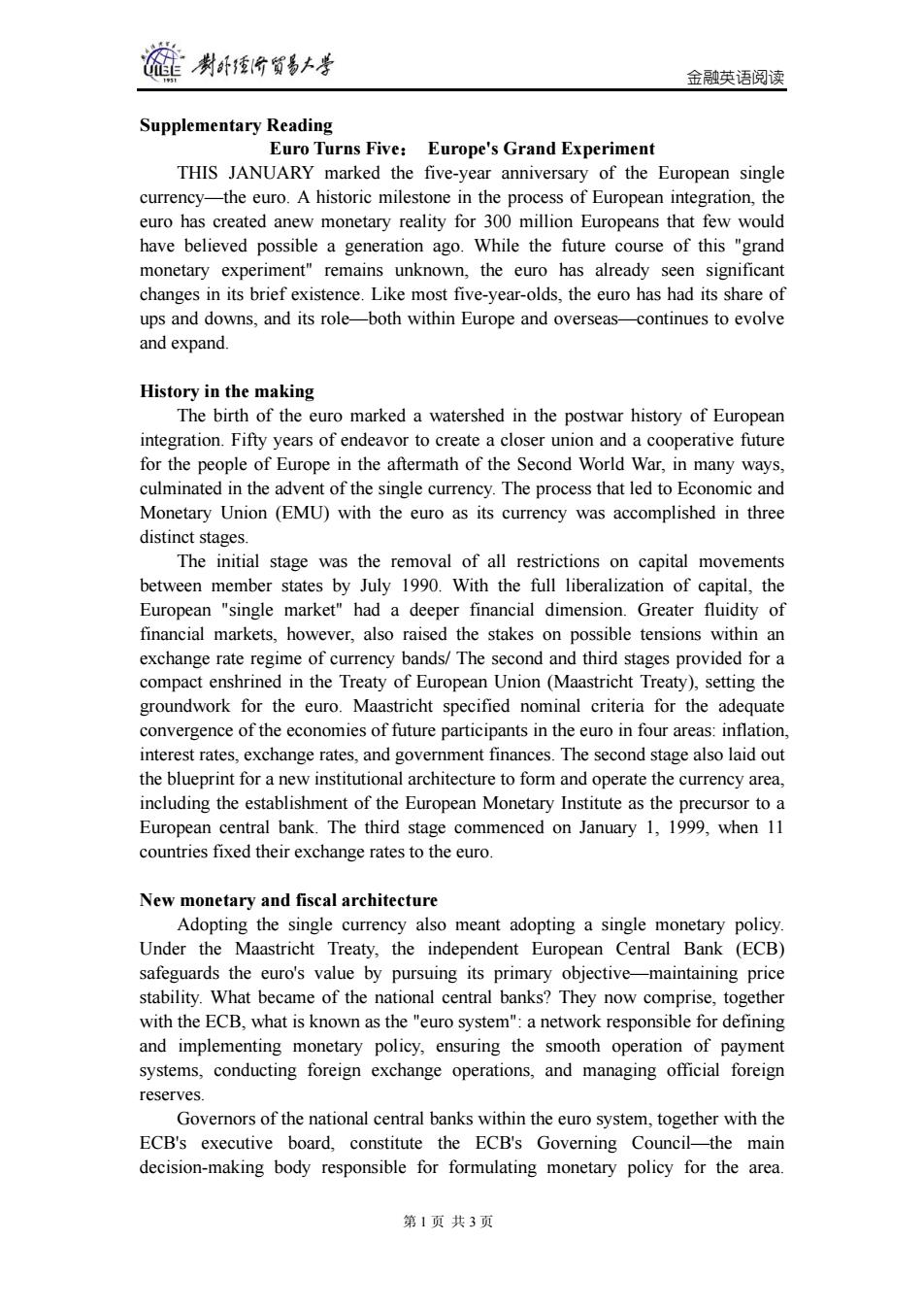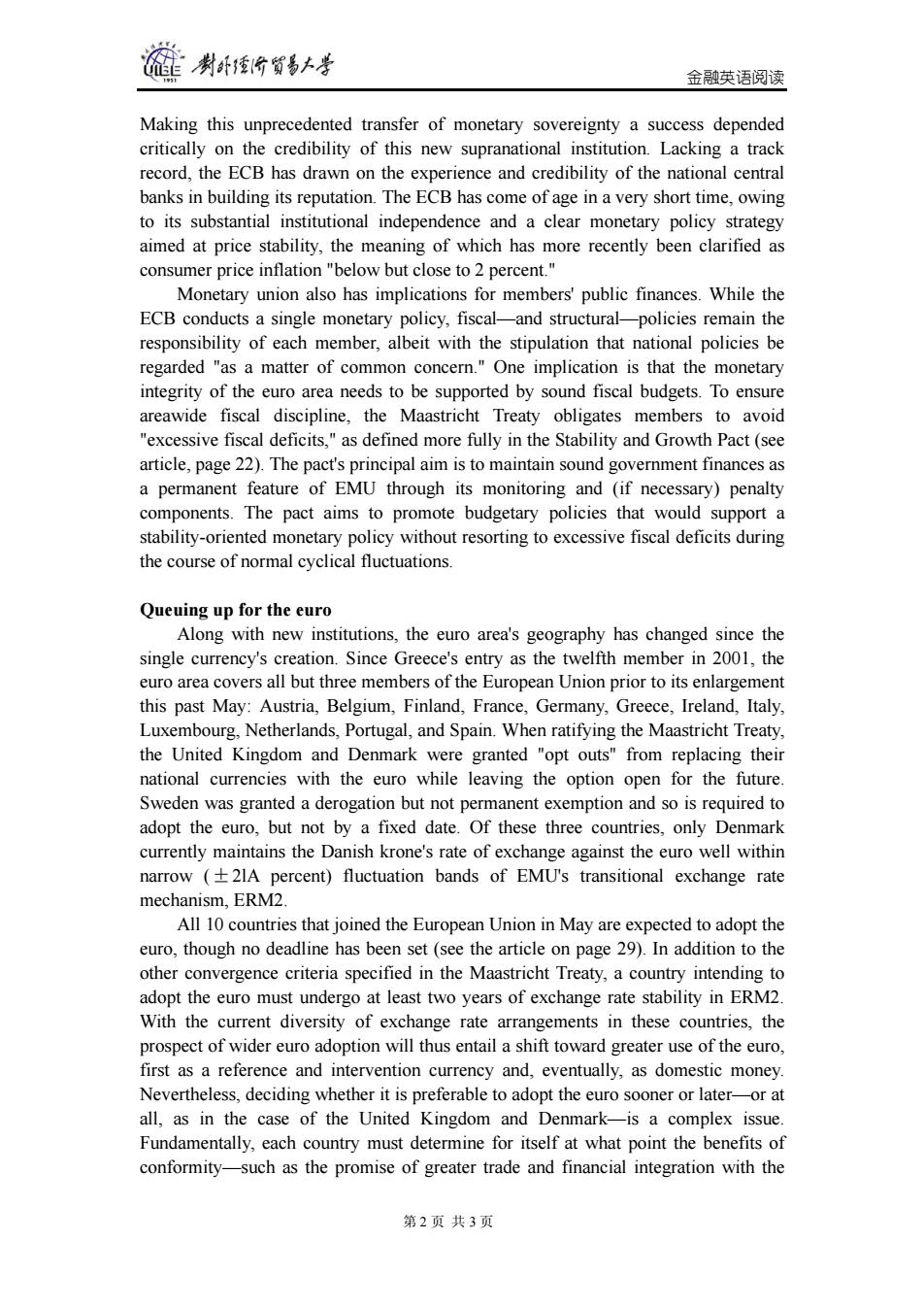
制卧台贸易上兰 金融英语阅读 Supplementary Reading Euro Turns Five:Europe's Grand Experiment THIS JANUARY marked the five-year anniversary of the European single currency-the euro.A historic milestone in the process of European integration,the euro has created anew monetary reality for 300 million Europeans that few would have believed possible a generation ago.While the future course of this "grand monetary experiment"remains unknown,the euro has already seen significant changes in its brief existence.Like most five-year-olds,the euro has had its share of ups and downs,and its role-both within Europe and overseas-continues to evolve and expand. History in the making The birth of the euro marked a watershed in the postwar history of European integration.Fifty years of endeavor to create a closer union and a cooperative future for the people of Europe in the aftermath of the Second World War,in many ways, culminated in the advent of the single currency.The process that led to Economic and Monetary Union (EMU)with the euro as its currency was accomplished in three distinct stages. The initial stage was the removal of all restrictions on capital movements between member states by July 1990.With the full liberalization of capital,the European "single market"had a deeper financial dimension.Greater fluidity of financial markets,however,also raised the stakes on possible tensions within an exchange rate regime of currency bands/The second and third stages provided for a compact enshrined in the Treaty of European Union(Maastricht Treaty),setting the groundwork for the euro.Maastricht specified nominal criteria for the adequate convergence of the economies of future participants in the euro in four areas:inflation, interest rates,exchange rates,and government finances.The second stage also laid out the blueprint for a new institutional architecture to form and operate the currency area, including the establishment of the European Monetary Institute as the precursor to a European central bank.The third stage commenced on January 1,1999,when 11 countries fixed their exchange rates to the euro. New monetary and fiscal architecture Adopting the single currency also meant adopting a single monetary policy. Under the Maastricht Treaty,the independent European Central Bank (ECB) safeguards the euro's value by pursuing its primary objective-maintaining price stability.What became of the national central banks?They now comprise,together with the ECB,what is known as the "euro system":a network responsible for defining and implementing monetary policy,ensuring the smooth operation of payment systems,conducting foreign exchange operations,and managing official foreign reserves. Governors of the national central banks within the euro system,together with the ECB's executive board,constitute the ECB's Governing Council-the main decision-making body responsible for formulating monetary policy for the area. 第1页共3页
金融英语阅读 Supplementary Reading Euro Turns Five: Europe's Grand Experiment THIS JANUARY marked the five-year anniversary of the European single currency—the euro. A historic milestone in the process of European integration, the euro has created anew monetary reality for 300 million Europeans that few would have believed possible a generation ago. While the future course of this "grand monetary experiment" remains unknown, the euro has already seen significant changes in its brief existence. Like most five-year-olds, the euro has had its share of ups and downs, and its role—both within Europe and overseas—continues to evolve and expand. History in the making The birth of the euro marked a watershed in the postwar history of European integration. Fifty years of endeavor to create a closer union and a cooperative future for the people of Europe in the aftermath of the Second World War, in many ways, culminated in the advent of the single currency. The process that led to Economic and Monetary Union (EMU) with the euro as its currency was accomplished in three distinct stages. The initial stage was the removal of all restrictions on capital movements between member states by July 1990. With the full liberalization of capital, the European "single market" had a deeper financial dimension. Greater fluidity of financial markets, however, also raised the stakes on possible tensions within an exchange rate regime of currency bands/ The second and third stages provided for a compact enshrined in the Treaty of European Union (Maastricht Treaty), setting the groundwork for the euro. Maastricht specified nominal criteria for the adequate convergence of the economies of future participants in the euro in four areas: inflation, interest rates, exchange rates, and government finances. The second stage also laid out the blueprint for a new institutional architecture to form and operate the currency area, including the establishment of the European Monetary Institute as the precursor to a European central bank. The third stage commenced on January 1, 1999, when 11 countries fixed their exchange rates to the euro. New monetary and fiscal architecture Adopting the single currency also meant adopting a single monetary policy. Under the Maastricht Treaty, the independent European Central Bank (ECB) safeguards the euro's value by pursuing its primary objective—maintaining price stability. What became of the national central banks? They now comprise, together with the ECB, what is known as the "euro system": a network responsible for defining and implementing monetary policy, ensuring the smooth operation of payment systems, conducting foreign exchange operations, and managing official foreign reserves. Governors of the national central banks within the euro system, together with the ECB's executive board, constitute the ECB's Governing Council—the main decision-making body responsible for formulating monetary policy for the area. 第 1 页 共 3 页

制卧价贸易上兰 金融英语阅读 Making this unprecedented transfer of monetary sovereignty a success depended critically on the credibility of this new supranational institution.Lacking a track record,the ECB has drawn on the experience and credibility of the national central banks in building its reputation.The ECB has come of age in a very short time,owing to its substantial institutional independence and a clear monetary policy strategy aimed at price stability,the meaning of which has more recently been clarified as consumer price inflation "below but close to 2 percent." Monetary union also has implications for members'public finances.While the ECB conducts a single monetary policy,fiscal-and structural-policies remain the responsibility of each member,albeit with the stipulation that national policies be regarded "as a matter of common concern."One implication is that the monetary integrity of the euro area needs to be supported by sound fiscal budgets.To ensure areawide fiscal discipline,the Maastricht Treaty obligates members to avoid "excessive fiscal deficits,"as defined more fully in the Stability and Growth Pact (see article,page 22).The pact's principal aim is to maintain sound government finances as a permanent feature of EMU through its monitoring and (if necessary)penalty components.The pact aims to promote budgetary policies that would support a stability-oriented monetary policy without resorting to excessive fiscal deficits during the course of normal cyclical fluctuations. Queuing up for the euro Along with new institutions,the euro area's geography has changed since the single currency's creation.Since Greece's entry as the twelfth member in 2001,the euro area covers all but three members of the European Union prior to its enlargement this past May:Austria,Belgium,Finland,France,Germany,Greece,Ireland,Italy, Luxembourg,Netherlands,Portugal,and Spain.When ratifying the Maastricht Treaty, the United Kingdom and Denmark were granted "opt outs"from replacing their national currencies with the euro while leaving the option open for the future. Sweden was granted a derogation but not permanent exemption and so is required to adopt the euro,but not by a fixed date.Of these three countries,only Denmark currently maintains the Danish krone's rate of exchange against the euro well within narrow (+21A percent)fluctuation bands of EMU's transitional exchange rate mechanism,ERM2. All 10 countries that joined the European Union in May are expected to adopt the euro,though no deadline has been set(see the article on page 29).In addition to the other convergence criteria specified in the Maastricht Treaty,a country intending to adopt the euro must undergo at least two years of exchange rate stability in ERM2. With the current diversity of exchange rate arrangements in these countries,the prospect of wider euro adoption will thus entail a shift toward greater use of the euro, first as a reference and intervention currency and,eventually,as domestic money. Nevertheless,deciding whether it is preferable to adopt the euro sooner or later-or at all,as in the case of the United Kingdom and Denmark-is a complex issue. Fundamentally,each country must determine for itself at what point the benefits of conformity-such as the promise of greater trade and financial integration with the 第2页共3页
金融英语阅读 Making this unprecedented transfer of monetary sovereignty a success depended critically on the credibility of this new supranational institution. Lacking a track record, the ECB has drawn on the experience and credibility of the national central banks in building its reputation. The ECB has come of age in a very short time, owing to its substantial institutional independence and a clear monetary policy strategy aimed at price stability, the meaning of which has more recently been clarified as consumer price inflation "below but close to 2 percent." Monetary union also has implications for members' public finances. While the ECB conducts a single monetary policy, fiscal—and structural—policies remain the responsibility of each member, albeit with the stipulation that national policies be regarded "as a matter of common concern." One implication is that the monetary integrity of the euro area needs to be supported by sound fiscal budgets. To ensure areawide fiscal discipline, the Maastricht Treaty obligates members to avoid "excessive fiscal deficits," as defined more fully in the Stability and Growth Pact (see article, page 22). The pact's principal aim is to maintain sound government finances as a permanent feature of EMU through its monitoring and (if necessary) penalty components. The pact aims to promote budgetary policies that would support a stability-oriented monetary policy without resorting to excessive fiscal deficits during the course of normal cyclical fluctuations. Queuing up for the euro Along with new institutions, the euro area's geography has changed since the single currency's creation. Since Greece's entry as the twelfth member in 2001, the euro area covers all but three members of the European Union prior to its enlargement this past May: Austria, Belgium, Finland, France, Germany, Greece, Ireland, Italy, Luxembourg, Netherlands, Portugal, and Spain. When ratifying the Maastricht Treaty, the United Kingdom and Denmark were granted "opt outs" from replacing their national currencies with the euro while leaving the option open for the future. Sweden was granted a derogation but not permanent exemption and so is required to adopt the euro, but not by a fixed date. Of these three countries, only Denmark currently maintains the Danish krone's rate of exchange against the euro well within narrow (±2lA percent) fluctuation bands of EMU's transitional exchange rate mechanism, ERM2. All 10 countries that joined the European Union in May are expected to adopt the euro, though no deadline has been set (see the article on page 29). In addition to the other convergence criteria specified in the Maastricht Treaty, a country intending to adopt the euro must undergo at least two years of exchange rate stability in ERM2. With the current diversity of exchange rate arrangements in these countries, the prospect of wider euro adoption will thus entail a shift toward greater use of the euro, first as a reference and intervention currency and, eventually, as domestic money. Nevertheless, deciding whether it is preferable to adopt the euro sooner or later—or at all, as in the case of the United Kingdom and Denmark—is a complex issue. Fundamentally, each country must determine for itself at what point the benefits of conformity—such as the promise of greater trade and financial integration with the 第 2 页 共 3 页

”制卧份贸易+学 金融英语阅读 euro area-outweigh the costs-notably,accepting a "one size fits all"monetary policy. Adapted from Finance Development June 2004 第3页共3页
金融英语阅读 euro area—outweigh the costs—notably, accepting a "one size fits all" monetary policy. Adapted from Finance & Development June 2004 第 3 页 共 3 页